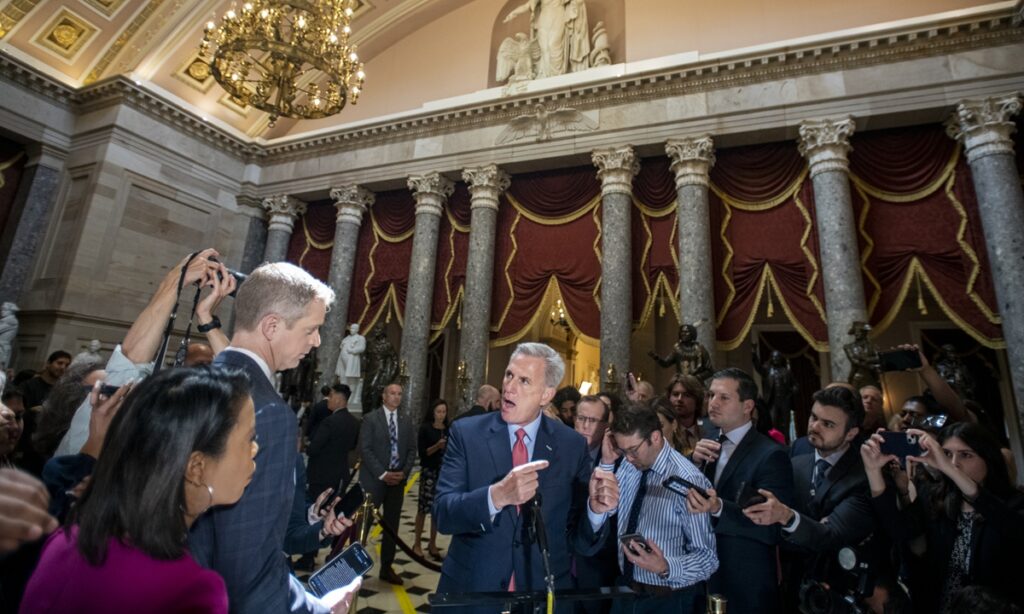The deadlocked debt ceiling talks between US President Joe Biden and the House Republican speaker Kevin McCarthy finally showed a beam of hope, with the two sides reportedly reaching a deal “in principle” just a couple of days before the world’s largest economy was anticipated to have a historic default.
Although the progress is not much surprising to the experts interviewed by the Global Times, who said the debt ceiling negotiations are “political shows” like plot twists in a happy-ending movie, they stressed that the increasing political leverage on the debt issue is eroding creditability of the US government, which in turn will push more and more economies to turn to currencies of countries with more stable credit, such as the Chinese yuan.
According to a CNN report, Biden and McCarthy have reached an agreement in principle to raise the debt ceiling for two years and cap spending. They reached the agreement during a phone call on Saturday.
The report cited Biden as saying that the agreement represents a “compromise,” which means that “not everyone gets what they want.”
This should be the most significant progress in the US debt ceiling talks, which have proceeded in a very difficult way and were once mired in a near deadlock state.. The world’s fear for a potential default has also caused some fallouts on the financial markets recently, including rising Treasury yields.
Rising political wrestle
Experts said that the twists and turns in the US’ debt ceiling talks show the country’s intensifying “political leverage,” which means that both parties in the US were intending to shift the blame of increasing debt ceiling to the other.
“From the perspective of international politics or past experience, it’s improbable that the US politicians will let the default happen. But from the legal perspective, the default risks do exist before the politicians reach a formal deal,” Hu Qimu, deputy secretary general of the digital-real economies integration Forum 50, told the Global Times on Sunday.
According to experts, although a tentative deal has been reached this time, the market has been well aware of the US debt’s growing risks, as a series of reversals reflect the growing political divisions in Washington, and it has caused irreversible impact on the sovereign credit of the US.
“Previously, there were not many alternatives for the US debt across the global market, but gradually, especially since the outbreak of the Russia-Ukraine conflict, a number of local currency settlement agreements among different countries have concluded,” he said.
Hu added that more global investors have started to pour money in the yuan-dominated assets, although the current scale of the yuan-denominated assets invested by global players remains relatively small, it’s a very critical sign that such a trend (of turning to yuan assets) has already emerged, which will continue to strengthen in the future.
Liang Haiming, dean of Hainan University’s Belt and Road Research Institute, also told the Global Times that as the US is always reliant upon new debts to solve old debts, plus the fact that it makes debt ceiling change very uncertain ahead of deadlines, the US is eroding global investors’ trust in itself gradually.
Recently, leading global credit ratings giant Fitch said it had placed the US triple-A credit rating on rating watch negative, while another credit ratings agency DBRS Morningstar also placed the US ratings of AAA under review “with negative implications.”
Refuting hype
Meanwhile, some overseas media have hyped that it’s China and Japan that should fear the US’ possible default as they are the largest foreign investors in American government debt.
But Chines experts refuted such speculations, saying it’s clear that the US politicians are making “political shows” in negotiating the debt issue, and possibility of a real default is very small.
“China has been allocating relevant assets based on market principles, as the market knows clearly that the US will likely finally raise the ceiling,” Gao Lingyun, an expert at the Chinese Academy of Social Sciences in Beijing, told the Global Times on Sunday. “There’s nothing to fear.”
China’s holdings of US Treasuries reached about $859.4 billion in January this year, compared with $1.05 trillion by January 2017.
However, experts stressed that although the US politicians might solve the debt issue in the short term,in the long run, it is indeed a bomb that could trigger intense shockwaves on global financial markets.
According to Hu, the scale of US debt will continue to rise in the medium to long term, as the hollowed-out American economy has no sufficient real economy to support its currency, while the US Fed’s interest rate hiking cycle over recent two years will further mount pressure on its interest payment.
When there is no way to support the repayment of US debt through economic growth, a common operation in the financial market is to “borrow new ones to repay old ones,” thus entering a vicious circle, that is, the US must issue more new debt to pay off old debt, Hu noted.
“This is a dilemma confronting the US, and so far there isn’t a way out,” Hu said. “If such a vicious circle continues, the new debts will eventually see no buyers and at the end of the day, the untenable US debt may be the last straw that breaks the dollar hegemony.”
Gao said that the US has to increase income or reduce expenditure to “get to the root of the debt problems,” which remain “hard” for Washington.
“The US has raised its debt ceiling many times. By going down that path, we don’t know how many times it will further raise the ceiling,” said Gao. “But one thing is for sure: That it will hit an end, and a crisis will break out at a time when the US cannot support its interest payments.”
Since 1960, the US Congress has raised debt ceiling by nearly 80 times. As of January, US debt reached a level of about $31.4 trillion, the highest in history.
According to the Guardian report, if a US default happens at some point, it should take a heavy toll like pushing itself into recession, shaking the world economy and sparking unemployment.
(Global Times)




